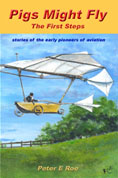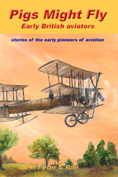|
The most complete anthology of early aviation pioneers ever published.
Each book focuses on a specific area in the development of heavier-than-air flight.
|

Click on image to see more detail
|
Pigs Might Fly:
The First Steps
Successful powered flight was the culmination of centuries of consideration, from its earliest documented record in England. Here are the fascinating stories of the lives of those early dreamers and pioneers of aviation, among them a 13th century cleric, a world-famous Renaissance artist, an inventive country squire, mariners who sought to sail in the sky and writers who helped lay the groundwork for the first century of flight.
Now available |

Click on image to see more detail
|
Pigs Might Fly:
The Gliders & Hoppers
In the late 19th century there were many aspiring aviators who brought aviation closer to fruition. These were inventive people who would have been influential in whatever field of endeavour they chose. Some came close to being the first to achieve powered heavier-than-air flight. In the absence of powerful lightweight engines many struggled to get airborne. Some even claimed that they achieved flight before the Wright brothers.
Now available |

Click on image to see more detail
|
Pigs Might Fly:
Early French Aviators
The Wright Brothers are recognised almost universally
as the first to fly a heavier-than-air powered aeroplane
at Kitty Hawk in North Carolina on 17 December 1903.
Their demands for licence fees from anyone flying in
their own country suppressed progress in America.
Initially disbelieving the Wright Brothers' claims and
wanting to be first to fly, the French became very
active and rapidly took the lead in early aviation
development.
Now available |

Click on image to see more detail
|
Pigs Might Fly:
Early British Aviators
The Wright Brothers are recognised almost universally
as the first to fly a heavier-than-air powered aeroplane
on 17 December 1903 in America. Progress in aviation in Britain was initially slow and the
French took an early lead. In August 1908 Wilbur Wright
demonstrated successful flight in France and, in July
1909, Louis Blériot flew his monoplane across the English
Channel. The momentum of British aviation rapidly increased.
Now available |
|
Pigs Might Fly:
Early North American Aviators
The Wright Brothers are recognised almost universally
as the first to fly a heavier-than-air powered aeroplane
on 17 December 1903 at Kitty Hawk in North Carolina. Unfortunately their protectionism and demand for fees from aviators flying any aeroplane in America delayed aviation progress there for years.
Their arch-rival was Glenn Curtiss and they followed him in establishing an exhibition team to market their aeroplanes. The majority of daredevil aviators of the 'exhibition era' flew Curtiss or Wright aeroplanes.
Now available
|

|
Pigs Might Fly:
Other Early Aviators
Outside of France Britain and America, there were a number of notable early pioneers in Europe and further afield. Many of these pioneers worked in isolation, away from the centres of aviation activity, adapting ideas they learnt from published material.
It is well recognised that the First World War stimulated rapid aeroplane development. Prior to the war, it was publishers, writers and sponsors who stimulated the aspirations of aviation pioneers to achieve success beyond most people's expectations.
Now available |